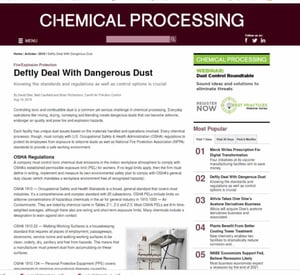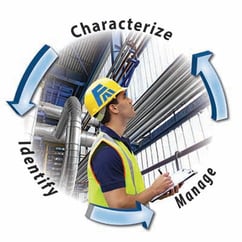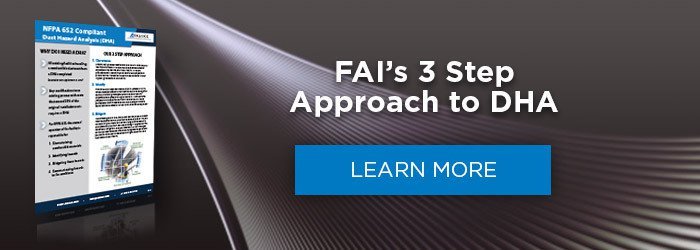In this month's Chemical Processing, authors David Steil, Matt Caulfield and Brian Richardson, of Camfil Air Pollution Control contribute a thorough piece "Deftly Deal with Dangerous Dust". Catchy alliteration aside, the article clearly outlines a roadmap for understanding OHSA regulations, reducing worker exposure, filters, NPFA standards, mitigating combustible dust, and explosion protection including passive and active devices.

As the authors point out, a DHA or DHA or Dust Hazards Analysis is key to determining if a dust is explosive is key to determining if a dust is explosive and is also required by the Authority Having Jurisdiction (AHJ).
Combustible dust experts can visit your facility to evaluate your receiving, storage, use, processing and disposal of all “powder” materials. They will evaluate existing dust management programs, handling practices, equipment, fire/explosion suppression systems, warning devices and onsite extinguishing capabilities. Possibilities for fugitive dust control will also be identified where appropriate. A comprehensive testing lab can provide the following services:
- Incident investigation for dust explosions and fires
- Evaluate compliance with relevant national, local and industry standards
- Electrostatic hazards – e.g. grounding and bonding issues
- Recommendations for explosion hazard risk reduction
- Identify dust sampling points and collect samples for dust explosibility testing
NFPA and OSHA NEP Combustible Dust Compliance
- Preparation for an OSHA Combustible Dust NEP inspection, including appropriate responses to inspector’s questions
- Perform a Process Hazard Analysis (PHA) for compliance with NFPA
- Documentation review for NFPA and OSHA Combustible Dust NEP requirements
- Testing services to meet all NFPA and OSHA Combustible Dust NEP requirements
- Conduct employee training to comply with OSHA Combustible Dust NEP requirements
Additional Engineering Services
- Vent size calculations for new or existing equipment (American and European standards)
- Ignition source evaluation (NFPA 654 and 77)
- Electrical area equipment classification (NFPA 499)
- Integration of combustible dust hazard management into existing process safety programs for process safety management (PSM) facilities
- Development of process safety programs to manage combustible dust hazards for non-PSM facilities
 Mitigation Strategy
Mitigation Strategy
Following a Dust Hazard Analysis (DHA), testing and engineering lab should provide a mitigation strategy. For those seeking an optimal balance between operability and cost, risk assessment products can create a simple but comprehensive solution based on probabilistic and statistical analysis.
Risk Assessment Products
- Human Factors Assessment
- ALARP
- Fire Protection Assessment
- Bayesian Network Design Optimization
Human Factors Assessment
- Program Development
- Design and Operation
- Use of Risk Based Approaches with Human Factor Modeling
Fauske & Assocates, LLC (FAI), for example, has advanced human factors experience capitalizing on the work done for the design and operation of the AP1000 plant. The results of the tests and human factor planning led to enhancements into the plant operating procedures and training program.
ALARP (As Low As Reasonably Practicable)
ALARP is a decision-making logic that, when applied correctly, results in actions or designs balanced between benefit and cost or effort. The ALARP concept requires applying the notions of: reasonability and practicability. It is difficult to clearly define what is reasonable and practicable, but simply put the process of assessing the risks to be ALARP is an assessment of the safety benefits against the expense of implementing the option to determine if the level of risk is tolerable.
Fire Protection Assessment
A thorough lab will review DHA findings and determine if there are recommendations and next steps for fire protection. This analysis would include the re-baselining of fire areas to support a fire hazard analysis (FHA). The product is an overall matrix to address audit findings, DHA findings and open recommendations.
Bayesian Network
This product uses Bayesian network methodology to demonstrate risk-based design and decision making. The quantification of the design criteria for each design alternative leads to the consideration of on-site and off-site risk. The overall optimization of these risks leads to lowered damage cost to process equipment and lower likelihood of population impact.
For more information regarding DHAs, check out our 3 step approach to proper dust hazards analysis.

